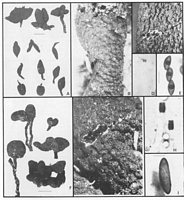|
 Xylaria luteostromata var. macrospora Xylaria luteostromata var. macrospora
BiostatusPresent in region - Indigenous. Endemic
Images (click to enlarge)
Caption: Fig. 3 A-E Xylaria luteostromata var. macrospora A, Stromata (PDD 45394). B, C, Surface of
stromata (left: PDD 28412, right: PDD 45394). D, Ascal ring (Melzer's reagent, PDD 45394). E,
Ascospores with germ slits (Melzer's reagent, PDD |
Description: Stromata: Stromata spherical, or upright (taller than broad); stipitate; 10-60 mm tall; 3-7 mm diam.; perithecia not visible; ostioles lower than or more or less equal to stromatal surface; stromatal surface wrinkled, or with peeling or flaking scales; dark brown (brown vinaceous), or blackish; KOH-extractable pigments lacking; tissue below perithecia conspicuous, essentially homogeneous, white.
Perithecia: Perithecia more or less globose; 0.3-0.5 mm diam.
Asci: Stipe short with spores filling about two-thirds of ascus; amyloid ring broader than high, or higher than broad.
Ascospores: Ascospores 11.5-14 µm long; 5-6.5 µm wide; brown; 0-septate; in side view inequilateral, flattened on one side, not curved; in face view fusoid, or elliptic; ends narrowly rounded. Germ slit straight, spore-length. Perispore indehiscent in 10% KOH.
Article: Rogers, J.D.; Samuels, G.J. (1987) [1986]. Ascomycetes of New Zealand 8. Xylaria. New Zealand Journal of Botany 24(4): 615-650 (http://www.rsnz.org/publish/abstracts.php).
Description: Stromata arising from decorticated wood, gregarious to solitary and scattered; unbranched
or rarely with one branch, (1.0-)1.5-3.0(-6.0) cm long; tip at first conidiogenous. Fertile
portion terminal; lanceolate to cylindric, rarely spathulate with broadest point median to
basal, 3-5(-7) mm, elliptic to circular in section, less frequently flattened. Stipe not sharply
delimited from the fertile portion, 3-20 mm x 1-2 mm, wrinkled, glabrous to velutinous
with short brown hyphae. Surface of stroma at first brown, later black with scant remains of
brown scales, slightly tuberculate to wrinkled with shallow creases between perithecial
elevations; perithecia completely immersed, 300-500 µm diam.; each opening through a
minute, mammiform papilla. Internal tissue of stroma white to very pale orange, orange
intensifying somewhat in 3% KOH, solid. Asci 110-140 µm total length x 6-7(-8) µm,
sporiferous portion (70-)80-105 µm, cylindrical; apical ring J +, wedge-shaped, 2.0-2.5 µm
wide x 2-3 µm high; 8-spored, ascospores uniseriate with overlapping ends. Ascospores
(10.0-)11.5-14.0(-16.5) x (4.0-)5.06.5 (-8.5) µm, inequilateral with one side flat and the
other side curved, elliptic in top view; brown, transparent; slit full length, parallel to long
axis of spore. Conidial stromata in vivo palmately branched above, ultimate branches white
from conidial formation. Conidiogenous cells forming a compact palisade, c. 25 µm long x
3 µm wide, pale brown, smooth; conidiogenous loci terminal, with 1 µm wide refractive,
frill-like scars remaining after conidial dehiscence. Conidia (8.0-)10.0-12.5 x (1.5-) 1.7-2.3(-3.0)
µm, narrowly ellipsoidal to nearly cylindrical, colourless, smooth; each with a flat, 1 µm wide,
refractive, frill-like basal abscission scar.
Habitat: HABITAT: On decaying wood of gymnosperms (Podocarpaceae: Dacrydium) and
dicotyledonous trees.
Distribution: NORTH ISLAND: Waikato, Bay of Plenty, Taupo, Wellington.
Notes: Xylaria luteostromata was described from Philippine specimens and was
considered by Lloyd to be much like X. castorea except for the pale yellow stroma (Lloyd
1919). We have examined type material [Philippines, A.D.E. Elmer no. 7217, Jan., 1906
(K)] and authentic material [Philippines, on wood, E.D. Merrill no. 10549, Lloyd no. 10406
(BPI); Philippines, on wood, Baker exsicc. no. 300, Lloyd no. 12899 (BPI)] and agree that
it is probably related to X. castorea. Our new variety macrospora differs from the typical
variety primarily in its larger ascospores.
|